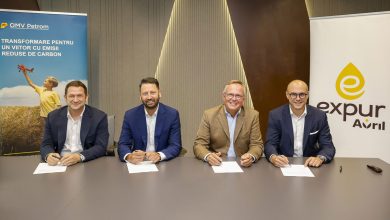Policy Paper by FPPG
Benefits of Carbon Capture, Utilisation and Storage (CCUS) Technology
The carbon capture, utilization, and storage (CCUS) technology can play a key role in achieving carbon neutrality, in addition to preserving the Romanian industry’s productivity and competitiveness, particularly in energy-intensive and difficult to decarbonate sectors.
CCS contributes to mitigating climate change by enabling the capturing of CO2 emissions before they can reach the atmosphere or by removing historical emissions from the air. CCS allows the industrial sector to continue its operations with low CO2 emissions, thus playing a key role in mitigating anthropogenic emissions. CCS can also help develop a platform for blue hydrogen, as an alternative energy source.
This policy paper explores the various types of CO2 storage method, analysing the benefits, challenges and opportunities arising from these. Current CCS projects and relevant best practises in Europe and across the world are also analysed, providing a comprehensive understanding of the current state of technological developments in the sector as well as of the diversity of business models adopted in various states.
Adequate geological structures for CO2 storage can be present both onshore as well as offshore, each type of geological formation presenting different opportunities and challenges. Geological storage is defined as the placement of CO2 in an underground formation, so that it remains stored there safely and on a permanent basis.
According to recent scientific research relating to the CCS sector, saline aquifers can store between 1.000 and 10.000 Giga tonnes of CO2. Concurrently, the storage capacity of depleted oil and gas geological structures amounts to 900 Giga tonnes of CO2 (Bourg et al, 20151). Specifically, the injection of CO2 in hydrocarbon reservoirs can ensure the permanent and safe underground storage of a significant quantity of CO2, while simultaneously improving the recovery of hydrocarbons (Enhanced Hydrocarbon Recovery), which allows a cut down in operational costs.
Depleted hydrocarbon deposits, both conventional and unconventional, could serve as geological storage of CO2 after hydrocarbon production if they meet specific technical criteria and the economic analysis demonstrates the feasibility of the project. It is worth noting that the gradual recovery of residual hydrocarbons after CO2 injection could reduce the costs of the CO2 storage operation.
Attention must be paid to ensuring that CCS projects are designed and implemented while considering the whole value chain (from capturing, via transport to storage), given the importance of the CCS technology and its impact across various sectors, as well as public infrastructure. These include oil and gas, cement and steel, glass, paper, but also transportation, agriculture, and environment. As upfront costs for developing CCS projects are significant, it is important to ensure that such initiatives are financially feasible and are accepted by all the parties involved.
Furthermore, as highlighted by numerous analyses and recent research conducted at international level, the CCS technology has the potential to generate new, highly skilled direct and indirect jobs across the industrial value chain.
Sectors such as oil and gas, considering their longstanding experience related to geology, reservoirs, in conducting drilling operations and operating oil and gas facilities and infrastructure, have unique expertise which can be easily transferred and used for the implementation of CCS projects, both in Romania and across the world.
Romania, as a country with long standing tradition in the exploration and exploitation of oil and natural gas, has a unique opportunity to implement and use the best practises and know-how at hand. Romanian oil and gas companies can significantly contribute to the development and implementation of CCS technology, given their expertise and skills in the sector.
With respect to implementing the legislative framework required to enable operators to use the CCS technology in Romania, FPPG dives into details regarding the Directives like the CCS Directive and accompanying Guidance Documents outline guidelines for safe CO2 storage operations, Emissions Trading System, the Net Zero Industry Act, and national legislation.
While the EU framework provides a basis for CCUS development, addressing implementation challenges is vital for Romania’s success in this area, Romania requires further regulatory adjustments and a national strategy for CCUS deployment, including identifying potential sites, engaging stakeholders, and ensuring social acceptance.
All aspects covered in this policy paper are critical for the successful deployment of CCUS initiatives in Romania.
OPPORTUNITIES TO INTRODUCE THE CCUS TECHNOLOGY IN ROMANIA
Storage
Petroleum systems are present in nine basins across Romania, as well as in the Romanian Black Sea continental platform. The Moesian platform covers more than 43,000 km2, with over 160 oil and gas fields having been discovered in the reservoir rocks of this platform. The Transylvanian Basin is about 300 km long and about 200 km wide, with more than 110 gas fields discovered. The Romanian Black Sea continental platform is located on the extension of two main onshore structural units.
All these reservoirs could potentially serve as storage reservoirs for CO2 storage, according to a European Association of Geoscientists and Engineers report (note that extensive technical feasibility studies need to be conducted to confirm which of the reservoirs can finally be considered suitable for CO2 storage).
Given the current situation, it is essential to emphasize that all initiatives regarding CO2 capture and storage require comprehensive investigation. Ensuring adherence to safety protocols and legislative standards regarding storage, especially concerning depleted reservoirs, is of utmost importance.
Major emitters are in the Gorj, Galati, Ploiesti, Constanta, Targu Mures and Bucharest areas. Romania has an important geological storage capacity for CO2, with estimates of theoretical storage potential amounting to 22.6 gigatons. However, additional studies are needed to refine these estimates as well as assess the technical and economic storage potential. The most comprehensive estimates relate to depleted hydrocarbon deposits, whereas most of Romania’s storage potential is linked to saline aquifers, which are less documented.
Currently, only two major oil and gas companies have proposed to capture and store CO2, with targets around 1.5 – 2 million tonnes per year, while Romania’s theoretical storage potential which includes saline aquifers which account for most of this storage potential, is estimated at around 22,600 million tonnes of CO2.
Romania ranked in 2016 in the top six member states which generated 56% of the EU’s emissions, alongside the Czech Republic, Germany, France, Italy, and Poland.
Romania’s geological potential (depleted hydrocarbon fields, saline aquifers)
There are three types of potential CO2 gas storage reservoirs, depending on the rock in which they are created to be stored:
- Depleted hydrocarbon reservoirs;
- Saline aquifers;
- Salt mines.
There are several advantages to depleted gas and oil fields. Specifically, these fields have stored gases and liquids for millions of years, their geological characteristics are well understood, and there is significant remaining storing capacity. In fact, numerous oil and gas fields are coming close to their economic field life.
Saline aquifer structures need extensive exploration activities before CO2 storage concepts can be developed and projects be matured.
The proven track record of salt caverns and abandoned mines for gas storage indicate these could provide alternative solutions for geological storage of CO2, particularly where the conventional storage options are limited or not available near a CO2 source. Salt caverns, along with depleted gas reservoirs and saline aquifers, have been used to store natural gas to meet seasonal cyclic or daily demand increase for several decades. Salt acts as a natural sealer, trapping the natural gas inside the cavern.
Romania’s technological potential
Carbon storage technology can be applied to industrial installations such as cement or steel plants, as well as power plants. It can also be used to produce blue hydrogen in the first stage of implementation of the EU Hydrogen Strategy. CCS can generate negative emissions if it is combined with biogenic sources of CO2, such as biomass.
Biogenic emissions are emissions resulting from natural sources.
CCS technology can be implemented across sectors that are vital to the economy, including cement, steel, fertilisers.
Romania has extensive experience and know how in the field of CCS projects and technologies, from the perspective of its long-standing tradition in the exploration and exploitation of oil and gas. Furthermore, research in the CCS sector has continued in Romanian universities and research institutions. After the depletion of hydrocarbon reservoirs, Romania can use offshore deposits to become an important player in the development of this key decarbonisation technology.
Examples of CO2 utilisation – Romanian and international projects
For instance, in Romania, Azomures has already developed capture and use facilities for carbon emissions. As of September 2021, the company has presented several solutions for carbon capture. These include a proposal to store CO2 emissions in underground deposits where natural gas has been extracted for years, and which can now serve as reservoirs for significant amounts of emissions. This solution required investments, including from the state, particularly in logistics infrastructure. According to the company, “there is enough underground space, former natural gas and oil fields, which can now be reused for CO2 storage”, adding that such procedures are already conducted in Western Europe. In addition, Azomures is implementing CCU in its calcium carbonate unit as an example of circular economy.
Another solution proposed by Azomures is to restore a centralised heating system for households in cities which have industrial platforms in their proximity. Targu Mures is such an example, where the steam resulting from the technological processes of the company can serve as a source of heating for homes.
In Israel, Shahar Solutions has developed a prototype device capable of capturing 100% of carbon dioxide emissions from internal combustion engines before turning it into synthetic natural gas for long term energy storage.
According to the Israeli company, the prototype, which is a special kind of balloon that can be sized to fit with a specific motor, collects emissions released from combustion engines of private cars trucks and even power plants.
The various substances released in the combustion process, such as carbon dioxide, nitrogen and water vapours are collected inside the balloon, where they undergo various chemical processes that separate the carbon dioxide from the rest of the particles. In the last stage of the process, the carbon dioxide is converted into methane.
The carbon dioxide – methane production technology used by this company is based on the Sabatier reaction, a scientific principle discovered in 1897 by Nobel Prize-winning French chemist Paul Sabatier. In line with this principle, both methane and water can be produced by combining hydrogen and carbon dioxide at 400°C and applying significant pressure in the presence of nickel.
Petra Nova CO2 capture and use facility in Texas, US, is a telling case of how a technologically feasible project initially failed because of adverse external financial conditions. The facility was shut down in 2020 due to very low oil prices, after four years of operation. The $1 billion carbon capture, utilisation and storage project resumed operations in September 2023, after a three-year shut down. The Petra Nova CCS project, owned by a subsidiary of JX Nippon Oil and Gas exploration, aims to capture 1.4 million tonnes of carbon dioxide per year, being one of the world’s largest CCUS initiatives.
The project began operating in 2016 at a coal-fired power plant in Texas, capturing CO2 and storing it permanently underground. The Petra Nova was “cited as a viable example of the technology when the US Environmental Protection Agency proposed new emission standards for power plants” in 2023. The project had received a $190 million grant from the US Department of Energy. Before shutting down in 2020, it captured around 3.8 million tonnes of CO2 during a three-year period.
The Petra Nova project sent the CO2 about 130 km by pipeline where it was pumped into an aging oil field to enhance output, a technique known as enhanced oil recovery.
CCS in the context of the energy transition
CCS is expected to generate new investments, and as a result produce revenues for the state budget, while preserving workplaces in the oil and gas sector which would otherwise disappear, in the context of the energy transition. Several schemes have been set in place by the European Commission to support CCS projects, including the Innovation Fund (with over 25 billion euros allocated for CCS initiatives), the Connecting Europe Facility (for cross-border CO2 transport networks), and the Recovery and Resilience Fund (for projects included in national plans), the Just Transition Fund, and the Modernisation Fund.
In the context of the ongoing approval of the Net Zero Industry Act, and the importance of ensuring projects’ economic feasibility, it is important to monitor the form in which the derogatory mechanism based on a demand and offer analysis of the injection capacity will be defined.
More importantly, taking into consideration the natural decline specific for Romania’s overall oil and gas resources, as well as the potential reduction in the related production in the context of the decreasing financing for oil and gas projects in the context of the energy transition, the potential to implement CCS projects, as a secondary activity to oil and gas operations, remains very significant.







